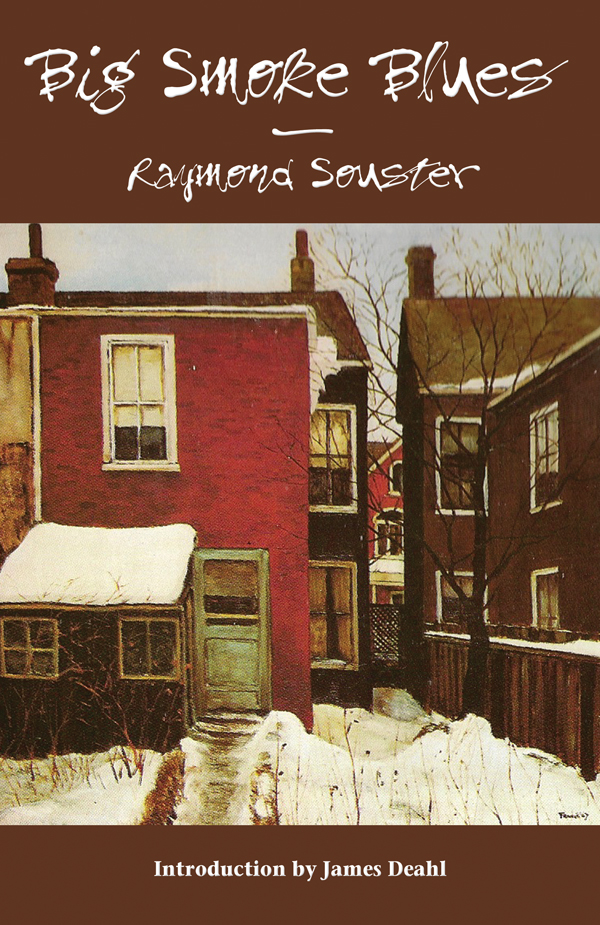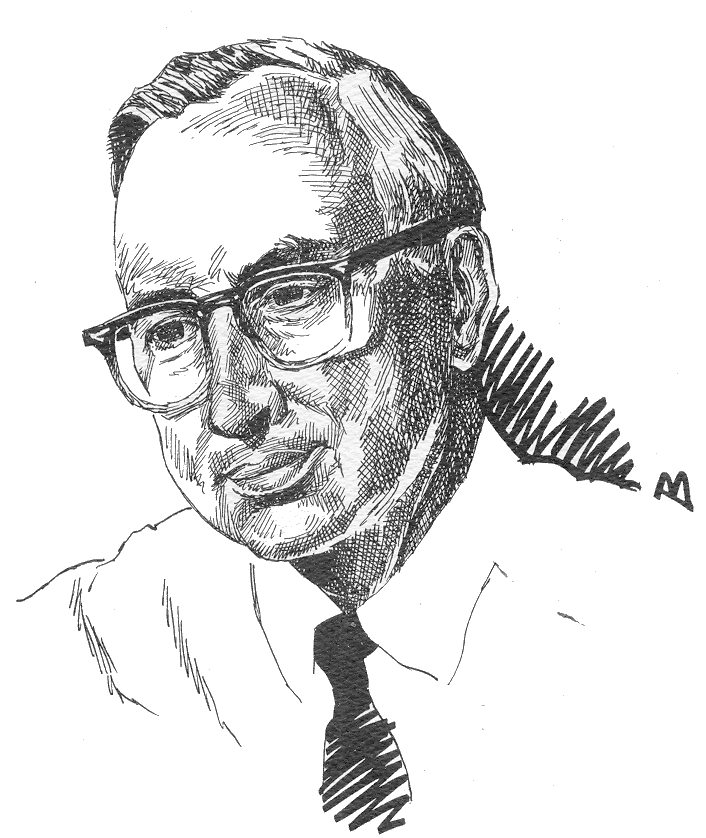



An Introduction
No one has written more lovingly, nor more honestly, about Toronto than Raymond Souster. Over the past 65 years in book after book, Toronto has been a major theme in Souster’s work. Now in his 90th year, this work continues with Big Smoke Blues.
Souster is the last active member of Canada’s great Modernist poets, a group born between 1916 and 1926. As always, his life and work are sustained by three pillars: his love for his wife Rosalia, his Christian faith, and his confidence in the power of sharp and decisive poetry. In Big Smoke Blues, Souster explores the role of memory in deepening his understanding of the world and of his place within it. The collection closes with the lines:
for the rest of my days
past memories like this
will continue
to wash over
the shores of memory.
And indeed, these poems reflect on the people, neighbourhoods, and places of old Toronto.
Literary and historical figures abound—Milton Acorn, Margaret Avison, Gwendolyn MacEwen, and Robert Weaver mingle with figures like William J. Stewart, Archibald Lampman, John Graves Simcoe, and the United Empire Loyalists. All are treated with sympathy and honesty. Much has been made of Souster’s "ironic vision" by Robert Billings and others. I prefer to talk about humour and affirmation. There is little bitterness in Souster’s poetry— instead one finds compassion. This is especially true when the poet deals with troubled friends such as Acorn or MacEwen. He remembers Milton Acorn leaving his cheque on the floor of Grossman’s Tavern following the ceremony in which he received the title "The Peoples’ Poet" and he expresses a deep sense of loss at the untimely death of Gwen MacEwen.
In general, the tone of these poems is one of quiet meditation. Food is remembered fondly, its sensuousness vividly portrayed in his mother’s baked apples with brown sugar, his mother-in-law’s polenta in chicken gravy, or his wife’s chili. Even bread pudding assumes a simple nobility.
The Junction District, Kensington Market, Toronto Islands, and Gerrard Street East are brought into focus, and readers see that in these neighbourhoods the past still lives today. Certainly the ethnic composition of Kensington has greatly changed, but it remains a microcosm of Toronto, a city in which a hundred tongues speak out as one.
Following William Carlos Williams, Souster realizes the power of a poetry rooted in place. Some of these places are gone: the Bohemian Embassy, the Village Bookstore, Pages Books, and Robert Simpson’s Department Store. But others are still vital parts of Toronto: Christie Pits, the C.N.E., Grenadier Pond, Wards Island, and Vesuvio’s Pizzeria & Spaghetti House.
Souster is no Pollyanna. He sings no song of innocence in which his youth was only delightful days when Mr. Peanut would visit Runnymede Public School. He also remembers the Depression when Chinese restaurants would offer a full-course meal for a quarter. Like Carl Sandburg writing of his beloved Chicago, Souster tells the whole story, and with affection.
Souster’s Toronto often starts in his backyard on Baby Point Road. Here his aged mulberry tree plays host to crows, juncos, starlings, and squirrels. Here also are his walks along the nearby Humber River, with its parks, opossums, and the occasional urbanized red fox. The Humber River valley is the setting for one of a handful of love poems to Rosalia, "Humber Afternoon." Another poem that displays his unfading love is "For a 62nd Anniversary."
Social issues are in no way lacking. There are poems dealing with homelessness and the need for proper social housing, the trap of current welfare laws, and the ever increasing level of crime, especially youth and street gang violence. So the poet writes:
Shootings
and shooting-ups
feed the continuous
nervous pulse
of the city’s heartland
There are many poems in Big Smoke Blues lamenting the prevalence of American-style street crime in what was once Toronto the Good, a problem neither the politicians nor the police seem competent to address.
Despite the decay of civil society, something of value endures. While old Tory Ontario is lost in the past, neighbourhoods survive. Although The Boat Portuguese restaurant has closed, other restaurants (some Portuguese) have opened in Kensington Market. And Wards Island is still a charming village for poets just as it was at the time when Milton Acorn and Gwendolyn MacEwen lived there.
Unlike his prior collections, Souster now offers five poems concerning his Christian faith. In "This Man of April" he affirms the presence of Jesus within our lives in this Easter meditation:
This Man of April
lives here
with us still
The poet states in "At Peace" that he has found solace in the arms of Jesus:
he’s found peace
nestled in
to his saviour’s
all compassionate grace.
In this poem, and throughout the book as a whole, Souster habitually refers to himself in the third person.
Souster is a member of Runnymede United Church. One of the few politicians he admires, William J. Stewart, was also in Runnymede’s congregation. In fact, Souster attended Sunday School with Stewart’s son. Stewart served as Toronto’s mayor during the Depression, and the poet praises his co-religionist for displaying "good common sense."
Readers will notice a distinct paucity of visual images.
There is nothing like
Rain-whipped leaf-ruin,
dying green-yellows,
already dead-crackling browns
in Big Smoke Blues. This is because Souster has gone blind and can no longer see the subjects of his poems. But his lack of vision is compensated for by the vitality and redemptive quality of his memory.
While most of these poems are set in the Toronto Souster has personally known for nine decades, history does appear in the form of John Graves Simcoe and the United Empire Loyalists. The Loyalists were the English-speaking founders of what we know today as Ontario. Souster observes that while they were the "cursed traitors" of the United States, they were Canada’s "steadfast, unsung heroes." Governor Simcoe (1752–1806) and his wife left behind
such goodwill
that a lake,
a town, and a street
still bear their name.
Simcoe’s vision of a common sense alternative to the United States has not worked out as planned. The present Americanization of our culture is, perhaps, an unintended consequence of the consumption of American culture, such as the poetry of Ezra Pound, William Carlos Williams, and Charles Olson. No one person is to blame, of course. Canada had the unfortunate fate to share a continent with a nation ten times as powerful and ten times as committed to the notion of progress. Progress was the flavour of the 20th century. But, as Souster suggests, Archibald Lampman would have grown to curse the 20th century
with every fibre
of his fragile body
had our great poet
been destined
to survive.
Big Smoke Blues closes with a section dealing with old age, illness, and mortality. Few poets take up these concerns, as common as they unfortunately are. Raymond Souster, however, is a brave poet who ducks no topic, not even pain and his own frail and failing body. While some people speak of "dying with dignity," all too few speak of living with dignity. These final poems, humane and with a seriousness softened by humour, written while in hospital and rehab centre, are a most welcome addition to Canadian literature. Our culture and our lives are enriched by this book.
— James Deahl
Hamilton, September, 2010
Other Books by Raymond Souster